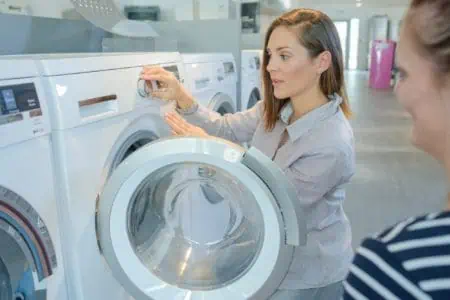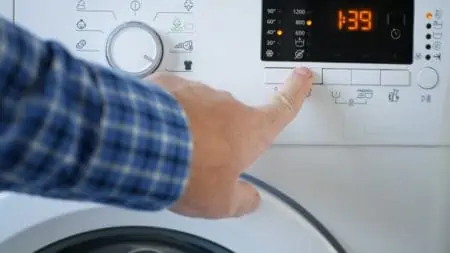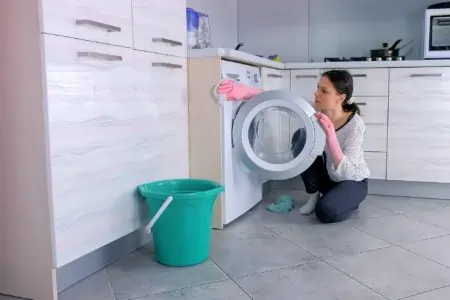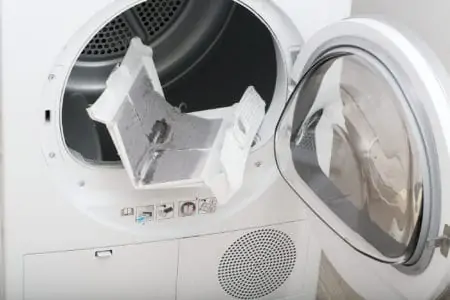Nothing is worse than a washer that is dancing around your laundry room. Its noise and excessive vibrations may damage the mechanism inside your washing machine, the dryer next to your washer, or items around the washer leading to costly repairs. It doesn’t matter if you have a front load or a top loading washing machine, you will need the same simple solution.
The solution is to make sure that the washer is level.
Key Takeaways
- Check to see if the load has become unbalanced because you’re washing heavy items or too large of a load.
- Use a spirit level to help you adjust the legs of your washing machine until it’s level.
- Build a platform underneath your washing machine to level an uneven floor.
- Use anti-vibration pads to prevent your washer from vibrating.
How to Tell If Your Washing Machine is Unbalanced
An unbalanced washing machine will bang around the laundry room, shake, and rock back and forth. You’ll hear loud noises coming from it.
The shaking may be enough to damage your machine or even the walls, floors, and items stored near your washer. If the shaking is strong enough, it may damage the hoses or connections causing future leaks.
What Causes a Washer to Be Unbalanced?
There are several reasons why your washing machine may be unbalanced. You may have started an extremely large load or might be washing a heavy item such as a king-sized comforter. This will unbalance your load but it is easily corrected by washing smaller loads or readjusting the items in the drum of your washer.
Washing machines have legs that will need to be adjusted to keep your washer level. If the legs aren’t adjusted correctly, your washing machine will be unbalanced.
The same is true if you have an uneven floor. While floors are even when a house is built, houses settle over time. This will cause the floor to become uneven and your washing machine to be unbalanced.
Another reason for a washing machine to become unbalanced is if the suspension springs become loose or wear out. If this happens, you will need to replace the suspension springs.
How to Level a Washing Machine
You can level a washing machine yourself by adjusting the legs, building a platform, or installing anti-vibration or leveling pads under the washer’s feet.
Adjust Washer Legs
When you’re adjusting the washer legs, start with the legs as short as possible. Short legs are more stable, shake less, and are less likely to break. New machines usually arrive with their legs fully retracted.
Lengthen the legs to level the machine.
Begin by laying a spirit level from side-to-side on top of the washing machine making sure that the level is placed on an area that’s flat and not curved. Look at the bubble. If it’s not in the center, then the washing machine is not level.
If your machine has metal legs, there is a locking nut at the base of the leg. You will loosen the locking nut with a wrench. Adjust the wrench until its jaws fit snugly against the nut and then turn the nut clockwise until it slides down the leg.
Once the nut is about ½ inch below the underside of the machine, turn the leg clockwise to shorten it or counterclockwise to extend it. Keep making small adjustments until your machine is balanced.
When your washing machine is balanced, close the wrench’s jaws over the nut and tighten the jaws if needed. Then rotate the nut counterclockwise until the nut is tight against the bottom of the machine. Hand tightens until the nut is snug but be careful not to overtighten or the nut will be difficult to loosen in the future.
Plastic legs are easier to adjust than metal legs. Begin by using adjustable pliers and opening the prongs wide enough to grab the bottom or ‘feet’ of the washing machine leg. If the base is octagonal, then you can use an adjustable wrench if it’s easier.
Squeeze the handles tight and turn the leg clockwise to lengthen it or counterclockwise to shorten it. Again, make small adjustments and frequently check to see if your washing machine is level.
If you have any problems holding up the machine to make the adjustments, you can lift the washer with a 4-inch by 4-inch wood block. This will hold it off the ground while you work. Then you can adjust the legs, remove the block, and check the level.
Repeat as needed until your washing machine is level.
Once your machine is level, level the machine from the front to back. Turn the spirit level so that it’s facing front to back on top of the washer, and look to see if the bubble is centered. If the bubble is centered, your washing machine is level.
Most washing machines have self-leveling legs in the back. However, the legs sometimes get stuck or rusted into place.
So, lift the back of your washer about 1 inch off the ground and let it drop back down. This usually loosens the legs so they can self-level. If the legs don’t budge, lift the back of the machine about 4-6 inches off the ground so you can tap the rear legs with the side of your wrench or pliers.
An older machine may not have self-leveling rear legs, so you will need to use the same procedure as you used to level the front legs. Remember to make small adjustments and check the level frequently.
When you’re finished leveling your machine, rock it back and forth as a final check.
Anti-Vibration Pads
Once you have leveled your washing machine, you can use anti-vibration pads to reduce noise and shaking.
Begin by lifting one corner of the machine. Slip a pad under the foot and mark the pad location on the floor. Repeat the procedure underneath each foot of your washing machine so you know where to place each pad.
Move the washing machine out of the way. Clean the floor underneath the pads. Then stick the washer pads’ adhesive discs to the floor.
Next, apply primer to the pads and press them onto the discs.
Then you will lift the washing machine back into place and put the feet into the pad recesses.
Leveling Platform
If your washing machine is on an uneven floor, the best solution is often to build a leveling platform to place underneath your washing machine. The platform doesn’t need to be tall, so you can lay one or more ⅝ – 1-inch pieces of plywood underneath the corners of your washing machine until it’s level.
Another option is to use 2/4s and a sheet of plywood to build a custom platform if you’d like.
Once the platform is built, adjust the feet of your washing machine until it’s level.
Washing Machine Level But Still Shakes
If your washing machine is level but is still shaking, you can check and replace parts such as the shock absorbers and the suspension springs. You can also wash smaller loads as the smaller loads are less likely to throw your washer off balance.
FAQs
How to Level a Washer
It doesn’t matter whether you have a Whirlpool or Maytag washing machine, if it begins dancing across your laundry room the first step is to check the load in your washing machine. It may have gone off balance during the spinning cycle because you’re washing heavy items or too large of a load.
Next, check to see if the legs on the washing machine need to be adjusted to balance your washer. You can also build a platform to level your washing machine if you have an uneven floor. Anti-vibration pads will also help to level your washer and prevent excessive vibrations.












